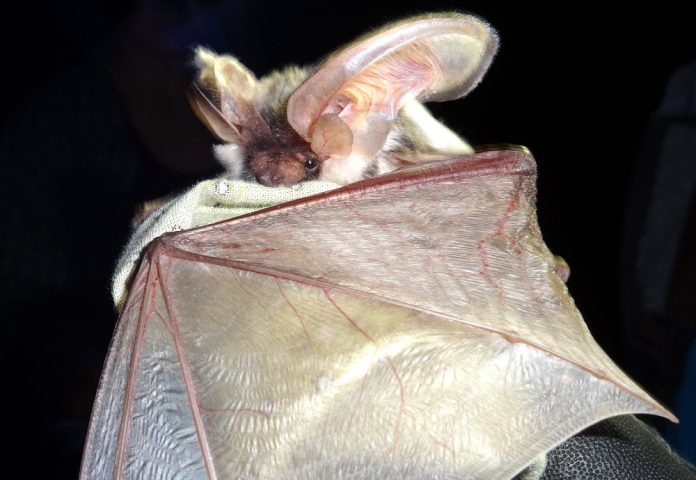Spring is upon the Verde Valley and the birds are chirping, foliage grows greener each day in Oak Creek Canyon and the critters are coming out of hibernation.
Bats are one species in particular that will be coming out of hibernation throughout April and will be returning to the skies to do what they do best. But what is it exactly that bats do? National Bat Appreciation Day on Tuesday, April 17, explored just that: The role bats play in nature.
Bats are nocturnal creatures, often remaining in the shadows. Some people may only catch a glimpse or two of a bat throughout the night, if they are lucky and keep their eyes peeled. However, while they may go unseen, the contributions that bats make to the environment in Northern Arizona and Sedona should not go unnoticed. Carol Chamber, a professor of wildlife ecology at Northern Arizona University and director of ecology of the Bat Ecology and Genetics Lab, noted that bats do more for people than what meets the eye.
“The bats up here are insectivorous,” Chambers said. “These bats will help control insect populations, and you might think of that as helping out with control of diseases like West Nile virus, so that’s what their main job is. Not to annoy people, but to go out and eat a lot of bugs.”
In Arizona, there are 28 known bat species, and in Northern Arizona 20 of those 28 species can be found, along with other bats that migrate to Sedona and Northern Arizona from across the United States.
“There are some really neat species that are moving through Sedona right now in large numbers, and one of those is the Mexican freetailed bat,” Chamber said. “They are migratory and they are insectivorous. They don’t hibernate here, they just to go find food farther south. They come through in large numbers, and they will be spending a few nights in the Sedona area or they will be here all summer and some will go farther north …. You can see them out flying around street lights trying to capture bugs.”
Two other bat species in Sedona that Chamber said also reap similar environmental benefits to that of the
Mexican free-tailed bat are the Allen’s lappet-browed bat and pallid bats.
Allen’s lappet-browed bats are usually found at lower elevations and are insectivorous, eating mosquitoes, beetles and other insects. What makes this a distinguished species is that they use echolocation to navigate.
Pallid bats are desert bats, which have blond or sandy-colored fur to match the desert environment. These insectivorous bats in particular help mitigate the scorpion population in Sedona.
“One of the things that makes [pallid bats] really cool is that they feed off scorpions,” Chamber said. “Around Sedona what you might notice is little bits of dead bugs on your porch overnight and sometimes you find little bits of dead scorpions, and that’s a pallid bat helping to control scorpion populations.”
The role bats play in the ecosystem of Northern Arizona is essential, down to each mosquito a bat eats to mitigate insect populations, as a single bat can eat 1,000 mosquitoes in one hour. However, Chamber noted that about nine of the 28 bat species in Arizona, may become threatened by white nose syndrome, a fungus that is present in cold and damp caves, which many bats species inhabit. According to Chamber, this is an emergent disease that may not affect all bat species, but rather hibernating bats like myotis bat species.
The disease has been spreading from the northeastern to the central United States at an alarming rate, and is caused by the fungus Pseudogymnoascus destructans, which infects the skin of the muzzle, ears and wings of hibernating bats.
According to Chamber, there have been no known cases of white nose syndrome in Arizona, though she said she believes it is not a matter of if the disease will come to the state, but when.
“We do have conditions that could allow it to be present,” she said. “We don’t know exactly how [the disease] is spread. Right now it’s in Texas, so it could appear in Arizona soon. It will probably come sooner than we hope. It would be great if it doesn’t occur here, but I’m sure it will get here. And given that it jumped across the continent, it could be in the next few years.”
On the bright side, Chamber looks ahead to the spring and summer that lie ahead for bats to continue carrying out their important role in the Northern Arizona ecosystem. To do that, Chamber said they need peace and little disturbance, which may require people to do a little more independent learning.
When hiking on forest service land in Sedona or throughout the rest of the Coconino National Forest, Chamber warns people to respect forest service signs indicating where bat roosting sites are in the area, and to think of places like caves, old mines, bridges and other confined places outdoors as possible maternity wards for bats that need little interference.
“In Northern Arizona I think humans tend to drive bats out of places, with disturbance of roosting site like people going into caves and disturbing bats there, that’s a big issue,” she said. “This time of year, and in the next few months bats are going to be having babies … disturbing those breeding sites can really damage the population.”
Makenna Lepowsky can be reached at 282-7795 ext. 126, or email mlepowsky@larsonnewspapers.com



